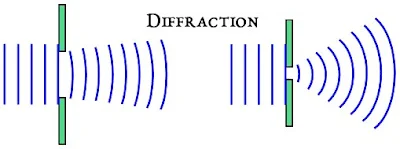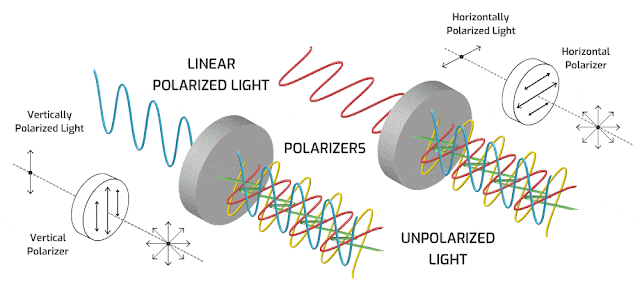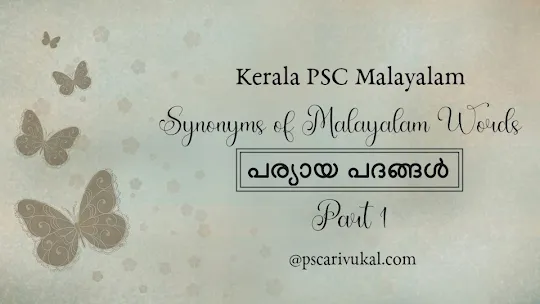This post just skims over the topic of "Light" and its properties for various PSC and other competitive exams. We have tried to include all the previous year PSC questions on this topic for the upcoming 10th level, plus two & Degree level PSC exams.
Light | Basic Physics Notes
- Study of Light – Optics.
- The primary source of light – Sun.
- Travels in straight lines.
- In the form of an electromagnetic wave.
- Made up of Photons.
- Smallest unit of light – Photons.
- Properties of Light – Reflection, Refraction, Total internal reflection & Dispersion.
- Incandescence – Emission of light from hot matter due to high temperature (eg: Meteors & Comets).
- Luminescence – Emission of light from cold-body radiation caused by subatomic motions, chemical reactions, electricul charges etc (eg: Fluorescence → Electrical charges, Chemoluminescence → chemical reactions, Photoluminescence → absorbption & re-emission of photons).
Speed, Time & Distance
- Speed of Light – 3 × 108 m/s.
- Speed of Light was first calculated by – Ole Christensen Roemer.
- Speed of Light is minimum in – Diamond.
- Speed of Light has a maximum speed in – Vacuum.
- The scientist who found out that the speed of light is maximum in vacuum is – Leon Foucault.
- Time taken by light to reach Earth from Sun – 8 Minutes & 20 Seconds (500 Seconds).
- Time taken by light to reach Earth from Moon – 1.3 Second.
- The distance traveled by the light in one year – Light Year.
- Light Year is a unit of – Distance.
- Light Year is used to measure the distance between stars.
- One Light Year – 9.46 × 1012 Km.
- The smallest unit used to measure distance in space is – Astronomical Unit.
- One Astronomical Unit (AU) – 1.5 × 108 Km.
- The distance between Earth & Sun – 1 AU.
- One parsec is – 3.26 Light Years.
- Particles that travel faster than light – Tachyons.
- Indian (Malayali) scientist who discovered Tachyons – E. C. G. Sudharsanan.
- The word Tachyons was first coined by the scientist – Gerald Feinberg.
- Particles that travel at 1/15 the speed of light – Alpha particles.
- Unit of Light Intensity (brightness of an illuminated surface) is measured in – candela.
- Unit of Luminous Flux (quantity of light emitted by a source) – Lumen.
Transparent, Translucent & Opaque
- Light can be absorbed, reflected, or transmitted.
- Objects that allow passage of light – Transparent Objects.
- Here light gets transmitted.
- Follows Snell's Law of Refraction.
- Eg: Glass, Water, Air, etc.
- Objects that allow only a portion of the light to pass through it – Translucent Objects.
- Appears Fuzzy or blurred.
- Eg: Wax paper, Butter Paper, Frosted glass, etc.
- Objects that don't allow passage of light – Opaque Objects.
- Or rather the light gets absorbed, reflected, or scattered.
- Eg: Wood, Metals, etc.
- Another example is the blackboard where the light gets absorbed completely and the surface appears black.
Electromagnetic Nature of Light
- Wave theory of light is put forward by – Christian Huygens (1678).
- The Electromagnetic Theory of light was put forward by – James Clerk Maxwell (1864).
- The scientist who discovered light is an electromagnetic wave – Heinrich Rudolph Hertz (1887, a demonstration of Maxwell's theory).
- The Corpuscular theory was put forward by – Descartes (1637).
- Explained & developed by – Sir Issac Newton.
- Light is made up of tiny particles called ‘corpuscles’ and travels in a straight line.
- The full range of wavelengths of light is called – Electromagnetic spectrum.
- The wavelength of Visible Light – 380–750 nanometres.
- An electromagnetic wave that carries more energy – Gamma Rays.
- The heat of the sunlight is felt due to the presence of – Infrared rays.
- Remote sensing in satellites makes use of – Infrared rays.
- Rays used in the Night vision goggles – Infrared rays.
- Rays that are involved in formation of vitamin D – Ultraviolet B (UVB) rays.
- Sunburns are caused by – Ultraviolet rays.
- An optical telescope detects – Visible light.
Colors
- The scientist who proposed that the sunlight consists of seven colors – Issac Newton (1665, Newton’s Color Theory: passed light through a prism).
- Visible light consists of – Seven colors (VIBGYOR- Violet, Indigo, Blue, Green, Yellow, Orange &Red).
- Primary Colors – Red, Green & Blue (RGB).
- Secondary Colors – Cyan, Magenta & Yellow (CMY), mixing of any 2 primary colors.
| Primary Colors | Secondary Colors |
|---|---|
| Red + Blue | Magenta |
| Red + Green | Yellow |
| Green + Blue | Cyan |
- The combination of primary and secondary color that forms white light – Complimentary color.
- Red + Cyan = White
- Green + Magenta = White
- Blue + Yellow = White
- Maximum wavelength – Red.
- Minimum wavelength – Violet.
- Maximum frequency – Violet.
- Minimum frequency – Red.
- Color that absorbs all other colors – Black.
- Color that reflects all other colors – White.
- Color that absorbs maximum heat – Black.
- Color that absorbs minimum heat – White.
- Most sensitive color to the human eye – Yellow.
- The blue color of the sea was explained by – C.V. Raman.
- The sea appears blue due to – Reflection of the sky and scattering of light by the drops of water.
- The blue color of the sky was explained by – Lord Rayleigh.
- The blue color of the sky is due to the phenomenon of – Rayleigh Scattering.
- The scattering of visible light due to colloidal particles called – Tyndall effect.
- The color of the sky when viewed from outside of the earth's atmosphere – Black.
- The color used in danger sign boards – Red.
- The color used in danger signboards in a lab – Yellow.
- The color of light used in vehicles during snowfall – Yellow.
- The color of the Green leaf in Red light – Black.
- The Red flower when looked through Blue glass appears – Black.
Rainbow
- Rainbow is formed due to – Dispersion, Refraction & Total internal reflection.
- Appears in the opposite direction of the Sun.
- Shape when looked from outer space – Circle.
- The color at the center of the rainbow – Green.
- The color that appears above the rainbow – Red.
- The color Red in the rainbow is seen at an angle of – 42.8°.
- Color that appears below the rainbow – Violet.
- The color Violet in the rainbow is seen at an angle of – 40.8°.
Colors & Different Lamps
| Lamps | Color |
|---|---|
| Chlorine Vapour Lamp | Green |
| Hydrogen Vapour Lamp | Blue |
| Mercury Vapour Lamp | White |
| Neon Vapour Lamp | Orange |
| Nitrogen Vapour Lamp | Red |
| Sodium Vapour Lamp | Yellow |
Properties of Light
Refraction
The phenomenon of bending of light beam ie, change in the direction when it travels from one medium to another is known as Refraction. This change in direction happens due to the change in the speed of the light beam.
- Twinkling of Stars.
- Spectrum of the Glass prism.
- Crepuscular Rays / Jacob's ladders.
- Camera
- Binoculars
- Telescope
- Microscope
- Glasses
- Eyes
- Snell's law.
Refractive Index / Refraction Index / Index of Refraction
It is the ratio of change in velocity (change in speed) of the light when it passes from one medium to another. The formula for the Refractive index is as follows:
Where 'n' is the refractive index, 'c' is the velocity of light in vacuum (3 × 108 m/s) & 'v' is the velocity of light in medium.n = c/v
The below table lists the Refractive Index (n) of different mediums:
| Medium | Refractive Index |
|---|---|
| Vacuum | 1 |
| Air | 1.0003 |
| Ice | 1.31 |
| Water | 1.33 |
| Glass | 1.52 |
| Diamond | 2.42 |
Total Internal Reflection
When a light ray traveling from a denser medium to the rarer medium, in this incident at the interface at an angle of incidence greater than the critical angle, then light rays reflected into the denser medium, this phenomenon is known as total internal reflection.
- Mirage,
- Sparkling of diamond,
- Sparkling of a water droplet,
- Endoscopes,
- Automotive rain sensors,
- LED Light Panels,
- Working principle of Optic Fibre.
- Father/Inventor of Optic Fibre Communications – Narinder Singh Kapany.
- Best reflector of light – Silver.
Dispersion
The process of splitting up of white light (visible light) into its 7 constituent colors (VIBGYOR), when passed through a prism, is called Dispersion.
- Rainbow,
- Dispersion of light in a Diamond,
- Dispersion of light on a CD
- The Scientist who explained the concept of Dispersion in 1666 was – Issac Newton.
Interference
The process of redistribution of light energy when two or more light waves from coherent sources superimpose is called Interference.
There are two types of interference. They are as follows:
a) Constructive interference (maximum intensity)
When two waves of equal frequency and wavelength collide, the crest of the first wave collides with the crest of the second wave and the trough of the first wave collides with the trough of the second wave.
That is to say, the crest and troughs of both waves will add up to form a wave having an amplitude equal to the sum of both the waves.
b) Destructive interference (minimum intensity)
When two waves of the same frequency and wavelength collide, the crest of the first wave collides with the trough of the second wave, and the trough of the first wave collides with the crest of the second wave.
That is to say, the crest and trough of both waves will cancel each other to form a wave with an amplitude zero.
- Different colors in a soap bubble,
- The colors that appear on the upper layer of oil spread on road.
- Holographs – The technique of recording and reproducing three-dimensional images (Holograms).
- The interference pattern using light waves was first observed by – Thomas Young (1801).
Diffraction
The slight bending of waves around the corners of an obstacle or through an opening or slit is called Diffraction.
Examples of Diffraction are as follows:
- The rings around the sun.
- The colors fringes seen on CD.
- The projector in the film theatre.
- The irregular, blurriness in the edge of shadows.
Polarisation
A light wave that vibrates in more than one plane is called unpolarized light.
The process of transforming the unpolarized light into polarized light ie, converting the vibration of a transverse wave into a particular direction, perpendicular to the direction of wave motion is known as Polarisation.
Nicol prism and Tourmaline are examples of polarizers.
- Polaroid filter
- Seismology
- Infrared spectroscopy.
Continue Reading:
📝SideNotes:
- Working principle of the periscope is an example of – Reflection & Refraction.
- Seismology – The study of earthquakes.
- X-ray was discovered by – Wilhelm Roentgen (1895).












Post a Comment
Post a Comment